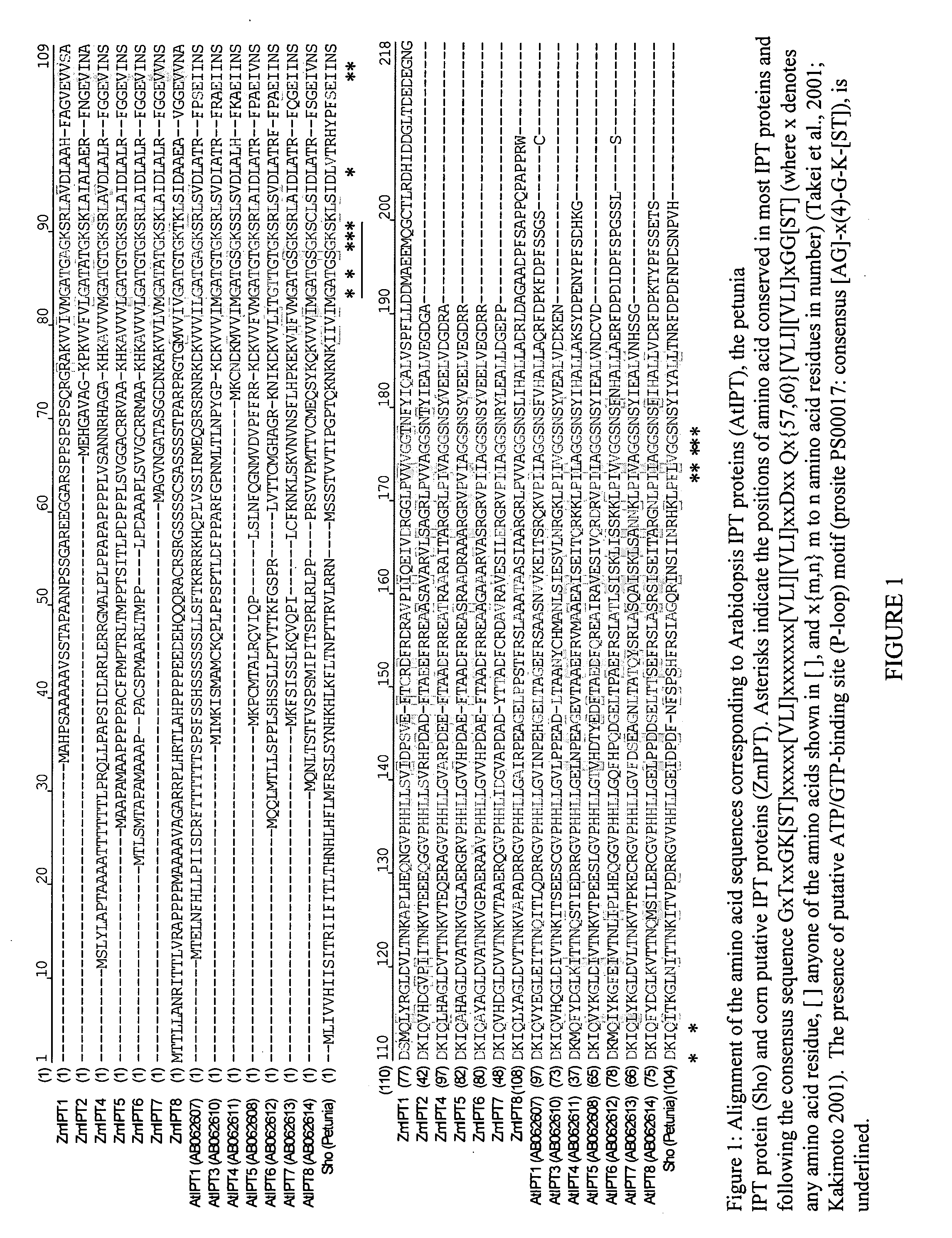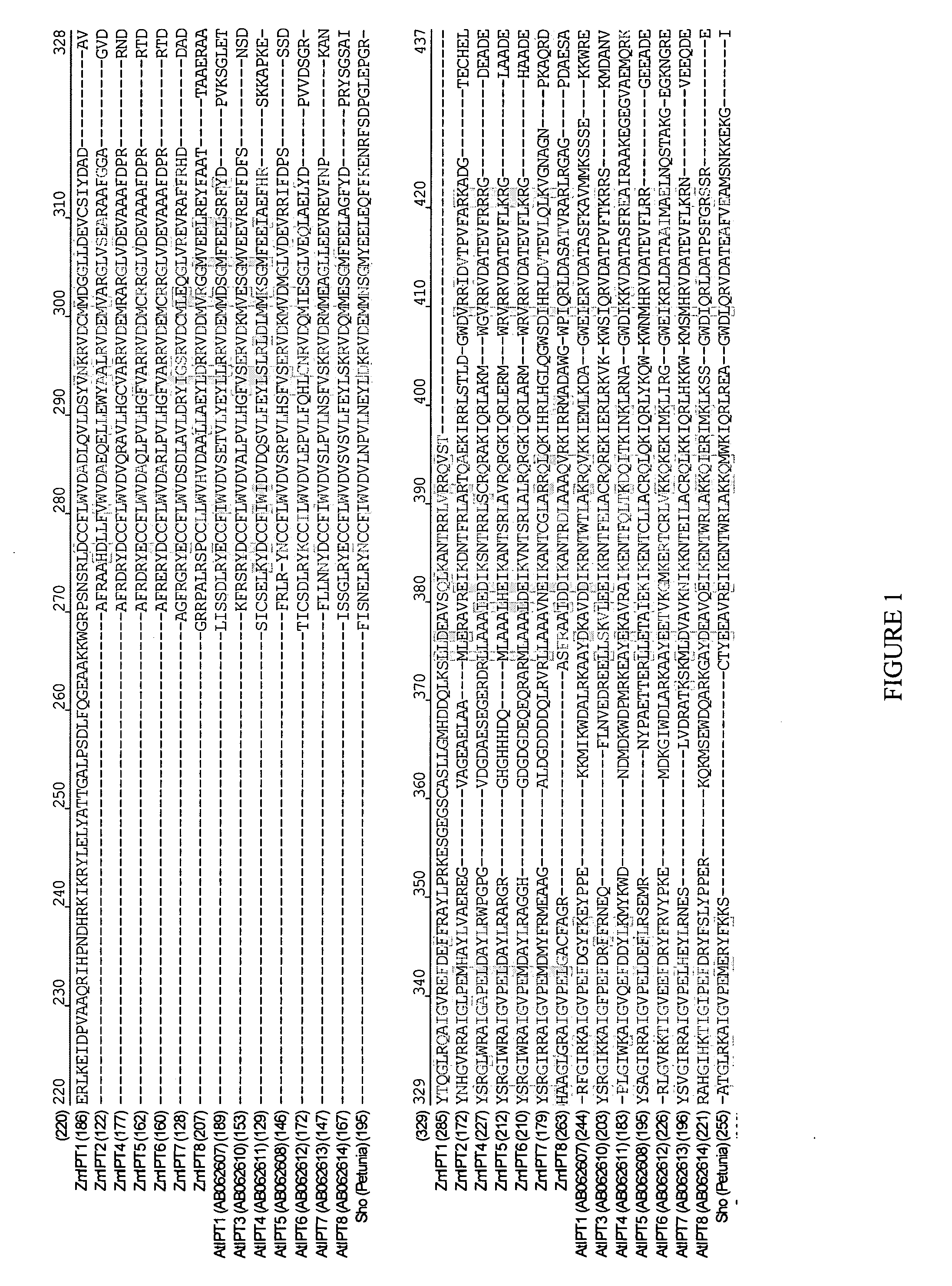Isopentenyl transferase sequences and methods of use
a technology of isopentenyl transferase and sequence, applied in the field of gene activity modulation of plants, to achieve the effects of reducing or eliminating the activity of an ipt polypeptide, reducing or eliminating the level of cytokinin in the plant, and modulating the root development of the plan
- Summary
- Abstract
- Description
- Claims
- Application Information
AI Technical Summary
Benefits of technology
Problems solved by technology
Method used
Image
Examples
example 1
Cloning and Gene Characterization of ZmIPT1
[0388] Below we describe the identification and characterization of an IPT polypeptide from maize designated ZmIPT1.
[0389] Material and methods: A Mo17 BAC library was screened using a 3′-end fragment of the ZmIPT1 cDNA from B73, identified by sequence similarity to Agrobacterium ipt. One of the positive clones was digested by HindIII, and subcloned into pBluescript. Recombinant plasmids were screened using colony screening and a 3′-end fragment as a probe. One positive clone was sequenced. Samples used for RT-PCR were harvested in the field from three individual plants. Five μg of total RNA was used for RT-PCR using ThermoScript RT-PCR System from Invitrogen. The reverse transcribed mixture for PCR used primers designed across an intron-exon-intron junction in order to avoid amplification of genomic DNA.
[0390] Results:
[0391] A. Deduced Protein Sequence:
[0392] Two putative maize ipt ESTs were identified whose deduced amino acid sequenc...
example 2
Gene Expression of ZmIPT1
[0399] One of the identified ZmIPT1 ESTs was from a B73 embryo library, the other one was from a developing root library. In order to gain an impression of the level of expression of ZmIPT1, a search of the Lynx database was performed. A perfect tag was found in the 3′-end of the gene, 231 bp from the poly A tail start. Tissue types, number of library hits, and average ppm are presented in Table 1. Expression was found to be very low in most organs, but higher in seedling and embryo libraries. In embryo libraries, expression was higher at 10 DAP than at later development stages (FIG. 4).
TABLE 1Number of Lynx libraries containing the ZmIPT1 tag and average ppmvalues.Tissue# of LynxAveragetypelibrariesppmSeedling129Ear54Endosperm28Embryo410.75Stalk19Leaf23Root22.5
[0400] Using RT-PCR, the expression pattern of ZmIPT in various maize organs and on a kernel developmental series was tested. No amplification product could be detected after 20 cycles, confirming ...
example 3
Isolation and Gene Characterization of ZmIPT2, ZmIPT4, ZmIPT5. ZmIPT6, ZmIPT7, ZmIPT8 and ZmIPT9
[0402] The AtIPT1 and AtIPT3 to AtIPT8 protein sequences were blasted against the six possible frames generated by the maize genomic sequences and searched for some degree of similarity. Because rice and maize genomes show a significant degree of synteny, the same method was used against rice genomic database to optimize this search. The rice sequences with an E-score of at least 200 were then used for an additional screen of the GSS maize database. Since at that time, the GSS database had not been assembled into contigs, the sequences obtained which had an E-score of at least 150 were pooled and aligned using Sequencher.
[0403] Using this method, eight maize contigs encoding putative CK biosynthetic enzymes were identified (ZmIPT2 to ZmIPT9), six of them showing an open reading frame without introns. The translated proteins corresponding to these putative genes contained 320 to 380 amin...
PUM
| Property | Measurement | Unit |
|---|---|---|
| Temperature | aaaaa | aaaaa |
| Temperature | aaaaa | aaaaa |
| Temperature | aaaaa | aaaaa |
Abstract
Description
Claims
Application Information
 Login to View More
Login to View More - R&D
- Intellectual Property
- Life Sciences
- Materials
- Tech Scout
- Unparalleled Data Quality
- Higher Quality Content
- 60% Fewer Hallucinations
Browse by: Latest US Patents, China's latest patents, Technical Efficacy Thesaurus, Application Domain, Technology Topic, Popular Technical Reports.
© 2025 PatSnap. All rights reserved.Legal|Privacy policy|Modern Slavery Act Transparency Statement|Sitemap|About US| Contact US: help@patsnap.com



